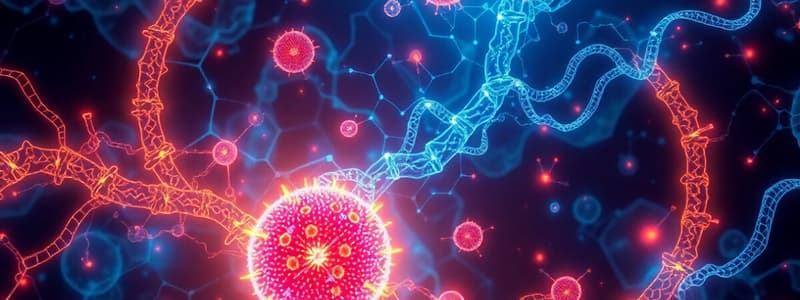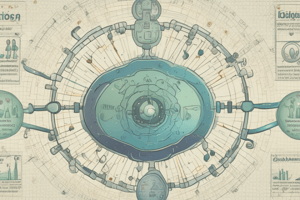Podcast
Questions and Answers
What is a primary function of amino acids in the body?
What is a primary function of amino acids in the body?
- Act as sole energy currency
- Store genetic information
- Regulate blood pressure directly
- Serve as building blocks for proteins (correct)
Which classification describes amino acids that cannot be synthesized by the body?
Which classification describes amino acids that cannot be synthesized by the body?
- Ketogenic amino acids
- Essential amino acids (correct)
- Non-essential amino acids
- Glucogenic amino acids
What role do B-group vitamins, particularly pyridoxine (B6), play in amino acid metabolism?
What role do B-group vitamins, particularly pyridoxine (B6), play in amino acid metabolism?
- Facilitate nitrogen removal from amino acids (correct)
- Promote the synthesis of nucleotides
- Enhance muscle growth directly
- Increase protein synthesis rates
What is the outcome of the urea cycle in terms of nitrogen processing?
What is the outcome of the urea cycle in terms of nitrogen processing?
Which statement best describes the relationship between amino acid metabolism and the TCA cycle?
Which statement best describes the relationship between amino acid metabolism and the TCA cycle?
What characterizes ketogenic amino acids?
What characterizes ketogenic amino acids?
What is a significant source of amino acids aside from dietary intake?
What is a significant source of amino acids aside from dietary intake?
Which class of amino acids includes those that the human body cannot synthesize and must be obtained from the diet?
Which class of amino acids includes those that the human body cannot synthesize and must be obtained from the diet?
What is the primary organ where most amino acid metabolism occurs?
What is the primary organ where most amino acid metabolism occurs?
Following deamination, into which central metabolic pathway do the carbon chains of amino acids primarily feed?
Following deamination, into which central metabolic pathway do the carbon chains of amino acids primarily feed?
What is the less toxic compound that ammonia is converted to in the liver?
What is the less toxic compound that ammonia is converted to in the liver?
Which of the following amino acids is classified as essential?
Which of the following amino acids is classified as essential?
What is the primary function of aminotransferases in amino acid metabolism?
What is the primary function of aminotransferases in amino acid metabolism?
Which essential amino acid is termed essential due to insufficient natural synthesis in humans?
Which essential amino acid is termed essential due to insufficient natural synthesis in humans?
Which pathway can amino acids contribute to after their deamination?
Which pathway can amino acids contribute to after their deamination?
Which amino acid specifically serves as a transporter of the amino group from muscle tissue to the liver?
Which amino acid specifically serves as a transporter of the amino group from muscle tissue to the liver?
What is the primary source of the first amine that enters the urea cycle?
What is the primary source of the first amine that enters the urea cycle?
Which compound is formed as a result of the urea cycle process that is recycled through the TCA cycle?
Which compound is formed as a result of the urea cycle process that is recycled through the TCA cycle?
Where does the synthesis of urea occur within the body?
Where does the synthesis of urea occur within the body?
Which reaction in the urea cycle occurs in the mitochondrial matrix?
Which reaction in the urea cycle occurs in the mitochondrial matrix?
What is the outcome of the reaction where aspartate donates its amine group in the urea cycle?
What is the outcome of the reaction where aspartate donates its amine group in the urea cycle?
What is the primary role of aminotransferases like ALT and AST in metabolism?
What is the primary role of aminotransferases like ALT and AST in metabolism?
What cofactor is essential for the enzymatic activity of aminotransferases?
What cofactor is essential for the enzymatic activity of aminotransferases?
Which amino acid is most commonly used as the donor of the amino group in transamination reactions?
Which amino acid is most commonly used as the donor of the amino group in transamination reactions?
What is the main result of oxidative deamination?
What is the main result of oxidative deamination?
Which statement is true regarding the reversibility of transamination reactions?
Which statement is true regarding the reversibility of transamination reactions?
What happens to the amino group during transamination?
What happens to the amino group during transamination?
Why is the measurement of ALT and AST levels significant in clinical tests?
Why is the measurement of ALT and AST levels significant in clinical tests?
Which keto acid is most commonly accepted by aminotransferases during transamination?
Which keto acid is most commonly accepted by aminotransferases during transamination?
How does pyridoxal phosphate assist aminotransferase enzymes?
How does pyridoxal phosphate assist aminotransferase enzymes?
What is a consequence of oxidative deamination on amino acid metabolism?
What is a consequence of oxidative deamination on amino acid metabolism?
What is the primary function of glutamate dehydrogenase in amino acid metabolism?
What is the primary function of glutamate dehydrogenase in amino acid metabolism?
Which statement best describes the relationship between ammonia and the blood-brain barrier (BBB)?
Which statement best describes the relationship between ammonia and the blood-brain barrier (BBB)?
What is a consequence of hyperammonaemia on neurotransmitter levels?
What is a consequence of hyperammonaemia on neurotransmitter levels?
Which pathways can amino acid catabolism contribute to?
Which pathways can amino acid catabolism contribute to?
What are the terminal stages of ammonia toxicity characterized by?
What are the terminal stages of ammonia toxicity characterized by?
What happens to ammonia produced during amino acid degradation?
What happens to ammonia produced during amino acid degradation?
Which of the following best describes oxidative deamination?
Which of the following best describes oxidative deamination?
What role do intermediates play in the metabolism of amino acids?
What role do intermediates play in the metabolism of amino acids?
Activation of NMDA receptors occurs due to which abnormal state related to ammonia?
Activation of NMDA receptors occurs due to which abnormal state related to ammonia?
After deamination, what is the primary fate of the removed nitrogen?
After deamination, what is the primary fate of the removed nitrogen?
Flashcards
Amino Acid Structure
Amino Acid Structure
Amino acids are small molecules with a carbon skeleton and an amine group (-NH2).
Amino Acid Roles
Amino Acid Roles
Amino acids are involved in protein synthesis, creating other molecules, and as energy sources during fasting.
Essential vs. Non-essential AA
Essential vs. Non-essential AA
Some amino acids are obtained from diet (essential), while others are produced by the body (non-essential).
Glucogenic/Ketogenic AA
Glucogenic/Ketogenic AA
Signup and view all the flashcards
Amino Acid Metabolism
Amino Acid Metabolism
Signup and view all the flashcards
Urea Cycle Role
Urea Cycle Role
Signup and view all the flashcards
Pyridoxine (B6)
Pyridoxine (B6)
Signup and view all the flashcards
Essential Amino Acids
Essential Amino Acids
Signup and view all the flashcards
Non-Essential amino acids
Non-Essential amino acids
Signup and view all the flashcards
Amino Acid Synthesis
Amino Acid Synthesis
Signup and view all the flashcards
Deamination
Deamination
Signup and view all the flashcards
Urea Cycle
Urea Cycle
Signup and view all the flashcards
Glucogenic amino acids
Glucogenic amino acids
Signup and view all the flashcards
Ketogenic amino acids
Ketogenic amino acids
Signup and view all the flashcards
Aminotransferases
Aminotransferases
Signup and view all the flashcards
Metabolic Fate of Amino Acids
Metabolic Fate of Amino Acids
Signup and view all the flashcards
Where does urea synthesis occur?
Where does urea synthesis occur?
Signup and view all the flashcards
What's the source of the first nitrogen atom for urea?
What's the source of the first nitrogen atom for urea?
Signup and view all the flashcards
How does the second nitrogen atom enter the urea cycle?
How does the second nitrogen atom enter the urea cycle?
Signup and view all the flashcards
What is the fate of fumarate in the urea cycle?
What is the fate of fumarate in the urea cycle?
Signup and view all the flashcards
Why is the urea cycle important?
Why is the urea cycle important?
Signup and view all the flashcards
Glutamate's Special Role
Glutamate's Special Role
Signup and view all the flashcards
Oxidative Deamination
Oxidative Deamination
Signup and view all the flashcards
Ammonia's Fate
Ammonia's Fate
Signup and view all the flashcards
Glutamate Dehydrogenase's Role
Glutamate Dehydrogenase's Role
Signup and view all the flashcards
What happens to the carbon chains?
What happens to the carbon chains?
Signup and view all the flashcards
Key Intermediates
Key Intermediates
Signup and view all the flashcards
Ammonia and the BBB
Ammonia and the BBB
Signup and view all the flashcards
Ammonium Toxicity Mechanisms
Ammonium Toxicity Mechanisms
Signup and view all the flashcards
Transamination
Transamination
Signup and view all the flashcards
Pyridoxal Phosphate (PLP)
Pyridoxal Phosphate (PLP)
Signup and view all the flashcards
α-Ketoglutarate
α-Ketoglutarate
Signup and view all the flashcards
Alanine Aminotransferase (ALT) & Aspartate Aminotransferase (AST)
Alanine Aminotransferase (ALT) & Aspartate Aminotransferase (AST)
Signup and view all the flashcards
Glutamate Dehydrogenase
Glutamate Dehydrogenase
Signup and view all the flashcards
Free Ammonia
Free Ammonia
Signup and view all the flashcards
Carbon Skeletons
Carbon Skeletons
Signup and view all the flashcards
Why is transamination important?
Why is transamination important?
Signup and view all the flashcards
Study Notes
Amino Acid Metabolism & Urea Cycle
- Amino acids are small biomolecules with unique chemical properties.
- They consist of a carbon skeleton and an amine group (-NH₂).
- They play various roles, including building blocks for proteins, precursors for important molecules like hormones, and fuel molecules.
- Amino acids are obtained from the diet and synthesized by the body (essential and non-essential).
- Excessive dietary protein is not stored but broken down to amino acids, then to intermediates such as pyruvate, oxaloacetate, or acetyl CoA.
- Excess amino acids can be converted to fat.
- At physiological pH, amino groups are positively charged (NH₃⁺) and carboxyl groups are negatively charged (COO⁻).
- Amino acids are considered as a carbon skeleton (alpha keto acid) plus an amino group.
- Careful handling of the amino groups is essential as ammonia is toxic.
Classification of Amino Acids
- Amino acids can be classified based on their physical-chemical characteristics, metabolic fate (glucogenic/ketogenic), and dietary requirements (essential/non-essential).
- Most amino acids are glucogenic (their carbon skeletons can be converted to glucose).
- Some (e.g., phenylalanine, tyrosine, and tryptophan) are ketogenic (their carbon skeletons are broken down to produce ketone bodies).
- Essential amino acids cannot be synthesized by the body and must be obtained from the diet.
- Non-essential amino acids can be synthesized by the body.
Amino Acid Biosynthesis
- The body requires essential amino acids from the diet.
- To synthesize non-essential amino acids, the body needs a source of carbon (a ketoacid) and an amine group donor (e.g., glutamate).
- Amino acid carbon skeletons are derived from various metabolic precursors, such as glycolysis, the TCA cycle, and the pentose phosphate pathway.
- Once formed, amino acids can be used to synthesize proteins and other important molecules.
Metabolic Fate of Dietary & Intracellular Protein
- All cells can modify amino acids, but mostly, amino acid metabolism occurs in the liver.
- Remodelling involves removing the amino group and recycling the carbon skeleton.
- Toxic ammonia is converted to urea in the liver, which is then excreted in urine.
Catabolic Fate of Amino Acids
- Following deamination, the carbon chains of amino acids enter central metabolic pathways.
- These pathways converge to seven key intermediates.
- Amino acid carbon skeletons can be used for glucose synthesis, fatty acid synthesis, or for energy production.
Metabolic Link Between Major Biomolecules
- Dietary protein contributes to tissue protein.
- Excess amines are converted to urea via the urea cycle.
- Carbon skeletons can be converted to pyruvate and enter the central metabolic pathways (e.g., TCA cycle or fatty acid synthesis).
Catabolism of Amino Acids: Deamination
- Most amino acids are deaminated in the liver.
- Deamination occurs through enzymatic reactions involving aminotransferases and glutamate dehydrogenase.
- Amino groups are safely transported to the liver via alanine.
Glucose-Alanine Cycle
- The glucose-alanine cycle involves transporting excess nitrogen from muscle to liver, and converting it into glucose via gluconeogenesis.
- This glucose is then exported back to the muscle for energy.
Four Key Amino Acids in Nitrogen Metabolism
- Glutamate, aspartate, glutamate, and glutamine play crucial roles in nitrogen metabolism, acting as acceptors or donors of amino groups.
Some Detail of Deamination
- Two key mechanisms, transamination and oxidative deamination, are involved in deamination.
- Transamination transfers an amino group to a keto acid, and involves no free ammonia.
- Oxidative deamination removes an amino group and forms ammonia, which also requires a cofactor (pyridoxal phosphate).
Catabolism of Amino Acids: Deamination - oxidative deamination
- Glutamate is the central amino acid for the removal of nitrogen from other amino acids and undergoes oxidative deamination to yield ammonia.
Overview of the Urea Cycle
- High levels of ammonia are toxic. The liver and kidneys work together to ensure that the level of ammonia does not accumulate.
- The urea cycle combines two amino groups into a urea molecule that is subsequently transported via the blood to the kidneys for excretion.
Formation of Urea
- One amine is derived from NH₄⁺ (obtained primarily via glutamate deamination).
- The second amine is derived from aspartate, which is formed from oxaloacetate in a transamination reaction.
Sources of Nitrogen for Urea Cycle
- The urea cycle uses nitrogen from various amino acid sources, including glutamate and aspartate.
Summary of the Urea Cycle
- Urea synthesis predominantly occurs in the liver through a series of reactions.
- Citrulline moves from the mitochondria to the cytosol to complete the remainder of the cycle.
- Urea is excreted via the kidneys.
Urea and TCA Cycles Overlap
- The urea cycle and TCA cycle overlap in their use of fumarate and oxaloacetate.
- Fumarate is converted to malate then to oxaloacetate in the TCA cycle which can then be a source of the second amino group used to make urea.
Connection Between Urea Cycle and TCA Cycle
- Urea Cycle and TCA cycle overlap through the intermediate fumarate.
Regulation of the Urea Cycle
- The urea cycle is largely regulated by a feed-forward mechanism that responds to increased ammonia levels.
- Dietary intake (especially protein) can modulate the rate of the cycle by impacting ammonia production.
- There are metabolic/hormonal factors that increase the cycle's rate, such as during fasting or increased amino acid metabolism following intake of higher protein.
Urea Cycle Disorders
- Defects in urea cycle enzymes can lead to dangerous ammonia buildup in the body.
- Symptoms (such as lethargy, coma, and even death) often appear in infancy.
Clinical Measurement of Urea
- Urea is a key metabolic waste product.
- Blood urea levels can be used to assess kidney or liver function.
- Increases or decreases from the normal urea concentration can indicate underlying issues in the metabolic pathways that are involved with the urea cycle.
Studying That Suits You
Use AI to generate personalized quizzes and flashcards to suit your learning preferences.



